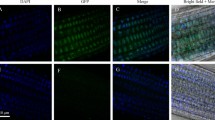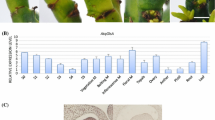Abstract
Recently, close relatives of class B floral homeotic genes, termed Bsister genes, have been identified in both angiosperms and gymnosperms. In contrast to the B genes themselves, Bsister genes are exclusively expressed in female reproductive organs, especially in the envelopes or integuments surrounding the ovules. This suggests an important ancient function in ovule or seed development for Bsister genes, which has been conserved for about 300 million years. However, investigation of the first loss-of-function mutant for a Bsister gene (ABS/TT16 from Arabidopsis) revealed only a weak phenotype affecting endothelium formation. Here, we present an analysis of two additional mutant alleles, which corroborates this weak phenotype. Transgenic plants that ectopically express ABS show changes in the growth and identity of floral organs, suggesting that ABS can interact with floral homeotic proteins. Yeast-two-hybrid and three-hybrid analyses indicated that ABS can form dimers with SEPALLATA (SEP) floral homeotic proteins and multimeric complexes that also include the AGAMOUS-like proteins SEEDSTICK (STK) or SHATTERPROOF1/2 (SHP1, SHP2). These data suggest that the formation of multimeric transcription factor complexes might be a general phenomenon among MIKC-type MADS-domain proteins in angiosperms. Heterodimerization of ABS with SEP3 was confirmed by gel retardation assays. Fusion proteins tagged with CFP (Cyan Fluorescent Protein) and YFP (Yellow Fluorescent Protein) in Arabidopsis protoplasts showed that ABS is localized in the nucleus. Phylogenetic analysis revealed the presence of a structurally deviant, but closely related, paralogue of ABS in the Arabidopsis genome. Thus the evolutionary developmental genetics of Bsister genes can probably only be understood as part of a complex and redundant gene network that may govern ovule formation in a conserved manner, which has yet to be fully explored.








Similar content being viewed by others
References
Becker A, Theissen G (2003) The major clades of MADS-box genes and their role in the development and evolution of flowering plants. Mol Phylogenet Evol 29:464–489
Becker A, Kaufmann K, Freialdenhoven A, Vincent C, Li MA, Saedler H, Theissen G (2002) A novel MADS-box gene subfamily with a sister-group relationship to class B floral homeotic genes. Mol Genet Genomics 266:942–950
Bowman JL, Alvarez J, Weigel D, Meyerowitz EM, Smyth DR (1993) Control of flower development in Arabidopsis thaliana by APETALA1 and interacting genes. Development 119:721–743
Carlsbecker A, Sundstrom J, Tandre K, Englund M, Kvarnheden A, Johanson U, Engstrom P (2003) The DAL10 gene from Norway spruce (Picea abies) belongs to a potentially gymnosperm-specific subclass of MADS-box genes and is specifically active in seed cones and pollen cones. Evol Dev 5:551–561
Causier B, Davies B (2002) Analysing protein–protein interactions with the yeast two-hybrid system. Plant Mol Biol 50:855–870
Debeaujon I, Nesi N, Perez P, Devic M, Grandjean O, Caboche M, Lepiniec L (2003) Proanthocyanidin-accumulating cells in Arabidopsis testa: regulation of differentiation and role in seed development. Plant Cell 15:2514–2531
Ditta G, Pinyopich A, Robles P, Pelaz S, Yanofsky MF (2004) The SEP4 gene of Arabidopsis thaliana functions in floral organ and meristem identity. Curr Biol 14:1935–1940
Duttweiler HM (1996) A highly sensitive and non-lethal beta-galactosidase plate assay for yeast. Trends Genet 12:340–341
Egea-Cortines M, Saedler H, Sommer H (1999) Ternary complex formation between the MADS-box proteins SQUAMOSA, DEFICIENS and GLOBOSA is involved in the control of floral architecture in Antirrhinum majus. EMBO J 18:5370–5379
Fan HY, Hu Y, Tudor M, Ma H (1997) Specific interactions between the K domains of AG and AGLs, members of the MADS domain family of DNA binding proteins. Plant J 12:999–1010
Favaro R, Pinyopich A, Battaglia R, Kooiker M, Borghi L, Ditta G, Yanofsky MF, Kater MM, Colombo L (2003) MADS-box protein complexes control carpel and ovule development in Arabidopsis. Plant Cell 15:2603–2611
Ferrandiz C, Gu Q, Martienssen R, Yanofsky MF (2000) Redundant regulation of meristem identity and plant architecture by FRUITFULL, APETALA1 and CAULIFLOWER. Development 127:725–734
Flanagan CA, Ma H (1994) Spatially and temporally regulated expression of the MADS-box gene AGL2 in wild-type and mutant Arabidopsis flowers. Plant Mol Biol 26:581–595
Flanagan CA, Hu Y, Ma H (1996) Specific expression of the AGL1 MADS-box gene suggests regulatory functions in Arabidopsis gynoecium and ovule development. Plant J 10:343–353
Fornara F, Parenicova L, Falasca G, Pelucchi N, Masiero S, Ciannamea S, Lopez-Dee Z, Altamura MM, Colombo L, Kater MM (2004) Functional characterization of OsMADS18, a member of the AP1/SQUA subfamily of MADS box genes. Plant Physiol 135:2207–2219
Gomez-Mena C, de Folter S, Costa MM, Angenent GC, Sablowski R (2005) Transcriptional program controlled by the floral homeotic gene AGAMOUS during early organogenesis. Development 132:429–438
Grossniklaus U, Schneitz K (1998) The molecular and genetic basis of ovule and megagametophyte development. Semin Cell Dev Biol 9:227–238
Honma T, Goto K (2001) Complexes of MADS-box proteins are sufficient to convert leaves into floral organs. Nature 409:525–529
Huang H, Tudor M, Su T, Zhang Y, Hu Y, Ma H (1996) DNA binding properties of two Arabidopsis MADS domain proteins: binding consensus and dimer formation. Plant Cell 8:81–94
Huelsenbeck JP, Ronquist F (2001) MRBAYES: bayesian inference of phylogenetic trees. Bioinformatics 17:754–755
Immink RG, Gadella TW Jr, Ferrario S, Busscher M, Angenent GC (2002) Analysis of MADS box protein–protein interactions in living plant cells. Proc Natl Acad Sci USA 99:2416–2421
Kaufmann K (2001) Molekulare Charakterisierung von Kandidatengenen für die Spezifizierung weiblicher Reproduktionsorgane in Angiospermen und Gymnospermen. Diploma Thesis, Friedrich Schiller University, Jena
Kaufmann K, Melzer R, Theissen G (2005) MIKC-type MADS-domain proteins: structural modularity, protein interactions and network evolution in land plants. Gene 347:183–198
Kumar S, Tamura K, Jakobsen IB, Nei M (2001) MEGA2: molecular evolutionary genetics analysis software. Bioinformatics 17:1244–1245
Liljegren SJ, Ditta GS, Eshed Y, Savidge B, Bowman JL, Yanofsky MF (2000) SHATTERPROOF MADS-box genes control seed dispersal in Arabidopsis. Nature 404:766–770
Ling M, Merante F, Robinson BH (1995) A rapid and reliable DNA preparation method for screening a large number of yeast clones by polymerase chain reaction. Nucleic Acids Res 23:4924–4925
Ma H, Yanofsky MF, Meyerowitz EM (1991) AGL1–AGL6, an Arabidopsis gene family with similarity to floral homeotic and transcription factor genes. Genes Dev 5:484–495
Mandel MA, Yanofsky MF (1998) The Arabidopsis AGL9 MADS box gene is expressed in young flower primordia. Sex Plant Repr 11:22–28
Mizukami Y, Huang H, Tudor M, Hu Y, Ma H (1996) Functional domains of the floral regulator AGAMOUS: characterization of the DNA binding domain and analysis of dominant negative mutations. Plant Cell 8:831–845
Nesi N, Debeaujon I, Jond C, Stewart AJ, Jenkins GI, Caboche M, Lepiniec L (2002) The TRANSPARENT TESTA16 locus encodes the ARABIDOPSIS BSISTER MADS domain protein and is required for proper development and pigmentation of the seed coat. Plant Cell 14:2463–2479
Parenicova L, de Folter S, Kieffer M, Horner DS, Favalli C, Busscher J, Cook HE, Ingram RM, Kater MM, Davies B, Angenent GC, Colombo L (2003) Molecular and phylogenetic analyses of the complete MADS-box transcription factor family in Arabidopsis: new openings to the MADS world. Plant Cell 15:1538–1551
Pelaz S, Ditta GS, Baumann E, Wisman E, Yanofsky MF (2000) B and C floral organ identity functions require SEPALLATA MADS-box genes. Nature 405:200–203
Pinyopich A, Ditta GS, Savidge B, Liljegren SJ, Baumann E, Wisman E, Yanofsky MF (2003) Assessing the redundancy of MADS-box genes during carpel and ovule development. Nature 424:85–88
Reidt W, Wohlfarth T, Ellerstrom M, Czihal A, Tewes A, Ezcurra I, Rask L, Bäumlein H (2000) Gene regulation during late embryogenesis: the RY motif of maturation-specific gene promoters is a direct target of the FUS3 gene product. Plant J 21:401–408
Riechmann JL, Krizek BA, Meyerowitz EM (1996) Dimerization specificity of Arabidopsis MADS domain homeotic proteins APETALA1, APETALA3, PISTILLATA, and AGAMOUS. Proc Natl Acad Sci USA 93:4793–4798
Rounsley SD, Ditta GS, Yanofsky MF (1995) Diverse roles for MADS box genes in Arabidopsis development. Plant Cell 7:1259–1269
Sagasser M, Lu GH, Hahlbrock K, Weisshaar B (2002) A. thaliana TRANSPARENT TESTA 1 is involved in seed coat development and defines the WIP subfamily of plant zinc finger proteins. Genes Dev 16:138–149
Schneitz K, Hülskamp M, Pruitt RE (1995) Wild-type ovule development in Arabidopsis-t haliana—a light-microscope study of cleared whole-mount tissue. Plant J 7:731–749
Smyth DR, Bowman JL, Meyerowitz EM (1990) Early flower development in Arabidopsis. Plant Cell 2:755–767
Steiner-Lange S, Gremse M, Kuckenberg M, Nissing E, Schachtele D, Spenrath N, Wolff M, Saedler H, Dekker K (2001) Efficient identification of Arabidopsis knock-out mutants using DNA-arrays of transposon flanking sequences. Plant Biol 3:391–397
Stellari GM, Jaramillo MA, Kramer EM (2004) Evolution of the APETALA3 and PISTILLATA lineages of MADS-box-containing genes in the basal angiosperms. Mol Biol Evol 21:506–519
Sun K, Hunt K, Hauser BA (2004) Ovule abortion in Arabidopsis triggered by stress. Plant Physiol 135:2358–2667
Theissen G (2001) Development of floral organ identity: stories from the MADS house. Curr Opin Plant Biol 4:75–85
Töpfer R, Matzeit V, Gronenborn B, Schell J, Steinbiss HH (1987) A set of plant expression vectors for transcriptional and translational fusions. Nucleic Acids Res 15:5890–5890
Tzeng TY, Liu HC, Yang CH (2004) The C-terminal sequence of LMADS1 is essential for the formation of homodimers for B function proteins. J Biol Chem 279:10747–10755
Unte US, Sorensen AM, Pesaresi P, Gandikota M, Leister D, Saedler H, Huijser P (2003) SPL8, an SBP-Box gene that affects pollen sac development in Arabidopsis. Plant Cell 15:1009–1019
Winter KU, Saedler H, Theissen G (2002a) On the origin of class B floral homeotic genes: functional substitution and dominant inhibition in Arabidopsis by expression of an orthologue from the gymnosperm Gnetum. Plant J 31:457–475
Winter KU, Weiser C, Kaufmann K, Bohne A, Kirchner C, Kanno A, Saedler H, Theissen G (2002b) Evolution of class B floral homeotic proteins: obligate heterodimerization originated from homodimerization. Mol Biol Evol 19:587–596
Yang Y, Jack T (2004) Defining subdomains of the K domain important for protein–protein interactions of plant MADS proteins. Plant Mol Biol 55:45–59
Yang Y, Fanning L, Jack T (2003) The K domain mediates heterodimerization of the Arabidopsis floral organ identity proteins, APETALA3 and PISTILLATA. Plant J 33:47–59
Acknowledgements
We thank Simona Masiero (MPIZ, Cologne) for valuable advice on the yeast-n-hybrid studies, Hans Sommer (MPIZ, Cologne) and Simona Masiero for providing the yeast-two-hybrid library and pTFT1 constructs, Ulrike Hartmann (MPIZ, Cologne) for providing yeast-two-hybrid plasmids encoding SEP proteins, and Richard Immink (PRI, Wageningen, Netherland) for providing plasmid pGD120. We are also indebted to Pia Nutt for producing the 35S::ABS-MIK transgenic plants and for general practical support, and to Rainer Melzer for useful discussions and general support. Many thanks to Britta Grosardt (MPIZ, Cologne) for technical assistance, and to the members of the ZIGIA group for the filter screen of the En1 population. We are grateful to Kay Schneitz (TU, Munich) for advice on the microscopic study of ovule structure, and to Annegret Tewes, Michael Melzer, Bernhard Claus (IPK, Gatersleben) and Annette Becker for help with the nuclear localization studies. Thanks to members of the An lab (POSTECH, Korea) for sharing sequence information
Author information
Authors and Affiliations
Corresponding author
Additional information
Communicated by G. Jürgens
Rights and permissions
About this article
Cite this article
Kaufmann, K., Anfang, N., Saedler, H. et al. Mutant analysis, protein–protein interactions and subcellular localization of the Arabidopsis Bsister (ABS) protein. Mol Genet Genomics 274, 103–118 (2005). https://doi.org/10.1007/s00438-005-0010-y
Received:
Accepted:
Published:
Issue Date:
DOI: https://doi.org/10.1007/s00438-005-0010-y




